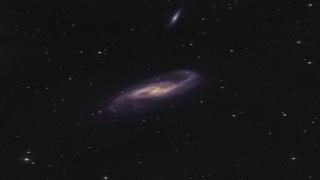Bibcode
Meidt, S. E.; Schinnerer, Eva; van de Ven, Glenn; Zaritsky, Dennis; Peletier, Reynier; Knapen, J. H.; Sheth, Kartik; Regan, Michael; Querejeta, Miguel; Muñoz-Mateos, Juan-Carlos; Kim, Taehyun; Hinz, Joannah L.; Gil de Paz, Armando; Athanassoula, E.; Bosma, Albert; Buta, Ronald J.; Cisternas, M.; Ho, Luis C.; Holwerda, Benne; Skibba, Ramin; Laurikainen, E.; Salo, H.; Gadotti, D. A.; Laine, Jarkko; Erroz-Ferrer, S.; Comerón, Sébastien; Menéndez-Delmestre, K.; Seibert, M.; Mizusawa, T.
Referencia bibliográfica
The Astrophysical Journal, Volume 788, Issue 2, article id. 144, 12 pp. (2014).
Fecha de publicación:
6
2014
Revista
Número de citas
234
Número de citas referidas
225
Descripción
We present a new approach for estimating the 3.6 μm stellar
mass-to-light (M/L) ratio Upsilon3.6 in terms of the
[3.6]-[4.5] colors of old stellar populations. Our approach avoids
several of the largest sources of uncertainty in existing techniques
using population synthesis models. By focusing on mid-IR wavelengths, we
gain a virtually dust extinction-free tracer of the old stars, avoiding
the need to adopt a dust model to correctly interpret optical or
optical/near-IR colors normally leveraged to assign the mass-to-light
ratio Upsilon. By calibrating a new relation between near-IR and mid-IR
colors of giant stars observed in GLIMPSE we also avoid the
discrepancies in model predictions for the [3.6]-[4.5] colors of old
stellar populations due to uncertainties in the molecular line opacities
assumed in template spectra. We find that the [3.6]-[4.5] color, which
is driven primarily by metallicity, provides a tight constraint on
Upsilon3.6, which varies intrinsically less than at optical
wavelengths. The uncertainty on Upsilon3.6 of ~0.07 dex due
to unconstrained age variations marks a significant improvement on
existing techniques for estimating the stellar M/L with shorter
wavelength data. A single Upsilon3.6 = 0.6 (assuming a
Chabrier initial mass function (IMF)), independent of [3.6]-[4.5] color,
is also feasible because it can be applied simultaneously to old,
metal-rich and young, metal-poor populations, and still with comparable
(or better) accuracy (~0.1 dex) than alternatives. We expect our
Upsilon3.6 to be optimal for mapping the stellar mass
distributions in S4G galaxies, for which we have developed an
independent component analysis technique to first isolate the old
stellar light at 3.6 μm from nonstellar emission (e.g., hot dust and
the 3.3 polycyclic aromatic hydrocarbon feature). Our estimate can also
be used to determine the fractional contribution of nonstellar emission
to global (rest-frame) 3.6 μm fluxes, e.g., in WISE imaging, and
establishes a reliable basis for exploring variations in the stellar
IMF.
Proyectos relacionados

Las Galaxias Espirales: Evolución y Consecuencias
Nuestro grupo pequeño esta bien conocido y respetado internacionalmente por nuestro trabajo inovativo e importante en varios aspectos de la estructura y la evolución de las galaxias espirales cercanas. Usamos principalmente observaciones en varias longitudes de onda, explotando las sinergías que nos permiten responder a las cuestiones más
Johan Hendrik
Knapen Koelstra